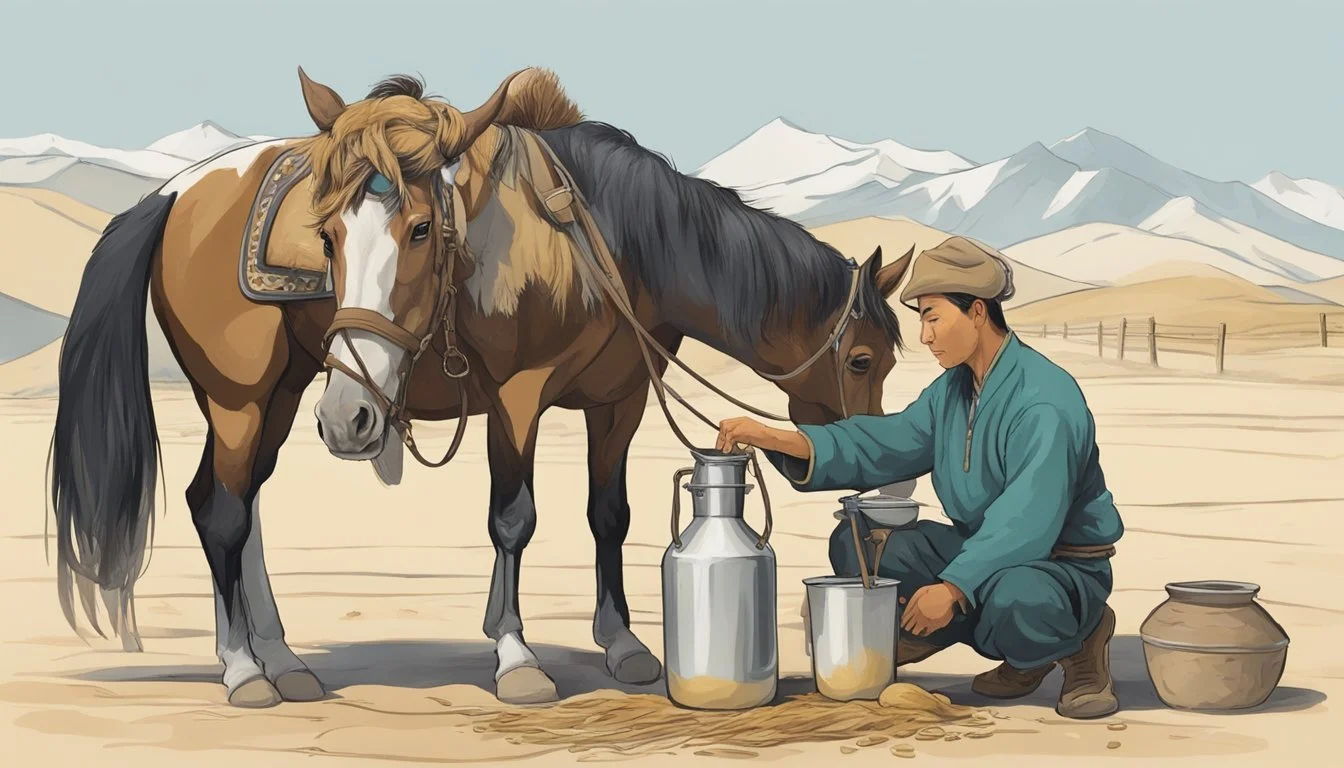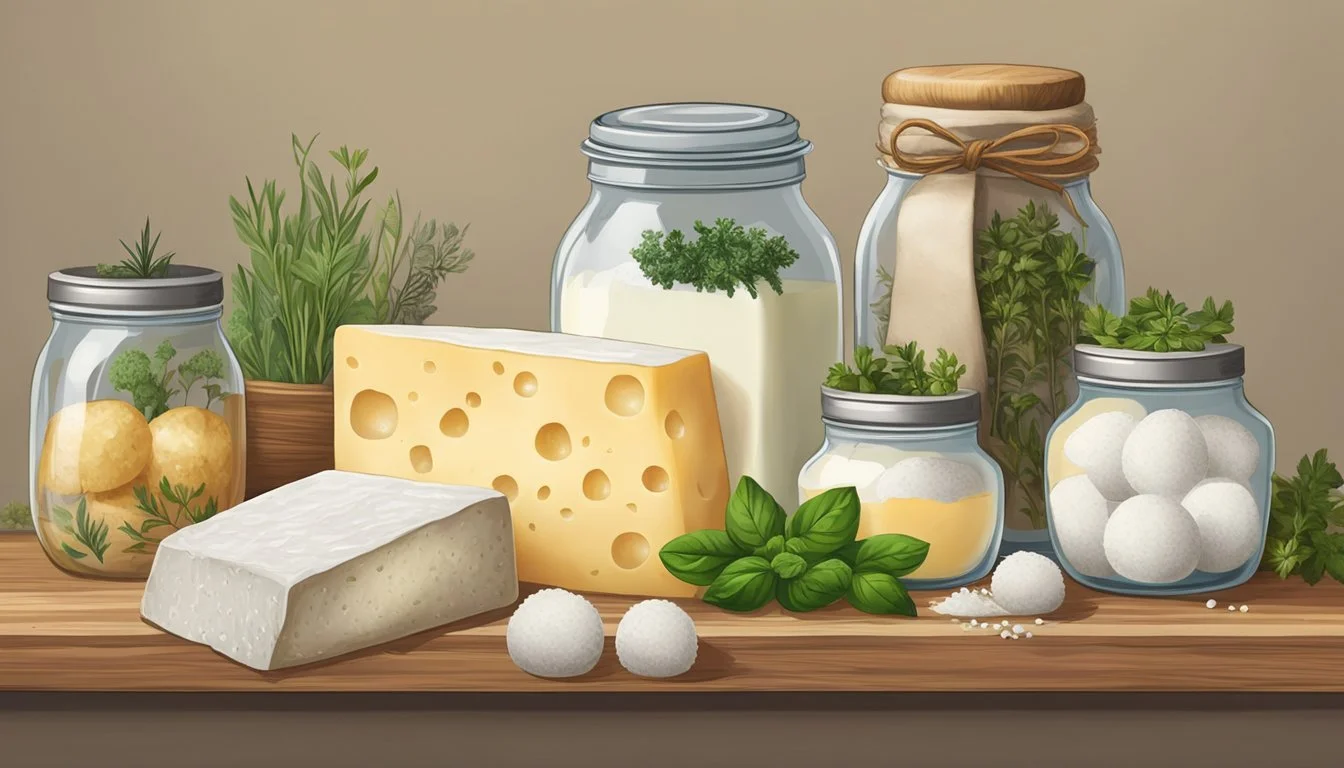Horse Milk Cheese
Unveiling the Kazakh Delicacy Known as Kurt
Kurt, a traditional Kazakh specialty, epitomizes the resourcefulness of Central Asian cuisine. This unique cheese (What wine goes well with cheese?) is made from fermented mare's milk and is a testament to the ingenuity of the Kazakh people. Historically, the nomadic tribes of Kazakhstan have relied on their livestock for sustenance, and kurt has been a way to preserve the nutritional value of milk in a portable form. Known for its distinctive flavor and long shelf life, this delicacy has become a staple within the region, reflecting intrinsic aspects of nomadic life and culture.
At its core, kurt represents more than just sustenance; it embodies a cultural connection to the past and a means of survival in the often harsh climate of Central Asia. The fermentation process gives this cheese its robustness, allowing it to withstand the test of time, which has been crucial for nomadic herders. Kurt is typically consumed as a snack and is revered for its high nutrient content, providing a source of energy and essential nutrients to support the demanding nomadic lifestyle. Its compact size and durability make it an ideal travel companion, illustrating the Kazakhs’ mastery of adapting their dietary practices to their environment.
The production of kurt involves a family-centric approach, with each member playing a specialized role. After the fresh milk is collected from mares or sheep, it is left to ferment, which involves a careful balance of time and traditional techniques passed down through generations. Once fermented, the milk is transformed into a curd, salted, and shaped into small, round balls that are left to dry until they harden. The result is a sharp, salty cheese that carries the essence of the Kazakh grasslands and the heritage of its people.
Historical Significance of Kurt
Kurt has been a resilient staple in the diets of Kazakh nomads, offering sustenance and preserving their dairy in harsh climates. It is intimately tied to their way of life and survival.
Ancient Nomadic Roots
Kurt, or qurt, traces its history back to the nomadic tribes of Central Asia. These tribes lacked refrigeration techniques and were constantly on the move, making it essential to create a food that could withstand long journeys on horseback. The ingenuity of drying fermented dairy products into hard balls meant these snacks (What wine goes well with snacks?) could be carried easily and would last for months. This practice not only provided nomads with essential nutrients their diet might otherwise lack but also played a critical role in their ability to traverse across the vast, challenging terrains of what is now known as Kazakhstan.
Kurt in Kazakh Culture
Kurt has long been entrenched in Kazakh culture, serving as more than just sustenance. It symbolizes the self-reliance and adaptability of the Kazakh people and their nomadic lifestyle. The preparation involves a family-centric approach, where each member contributes to the process – from milking sheep or mares to shaping the cheese into balls. This shared activity strengthens familial bonds and ensures the passing down of culinary traditions through generations. As a preserved form of dairy, kurt is also utilized during times when fresh milk is not available, highlighting its importance in the cultural heritage and food security of the region.
The Making of Horse Milk Cheese
Horse milk cheese, known as 'Kurt,' is a testament to the ingenuity of Kazakh culinary traditions. This dairy product not only offers a rich source of protein but also embodies the storied nomadic lifestyle of the Central Asian steppes.
Milking the Mares
The initiation of ‘Kurt’ production begins with the careful milking of mares. Traditionally, these horses are part of the vast herds that roam the Kazakh landscapes. The milking process requires skill and timing, ensuring the milk is fresh and retains its nutritional value.
Fermentation Process
Once collected, the mare's milk undergoes fermentation, a critical step to achieve the desired tanginess and to develop the right properties for cheese making. Natural bacteria in the milk initiate this process, transforming the milk into a thick, yogurt-like substance that sets the stage for ‘Kurt’s unique characteristics.
Shaping and Drying
After fermentation, the dairy product is meticulously shaped into small balls. The shaping is not merely for aesthetics; it facilitates uniform drying. These shaped balls are then dried until they achieve a firm texture. Drying not only extends the cheese's shelf life but also intensifies the flavor.
Salting the Cheese
The final step in the production of 'Kurt' is salting. Generous amounts of salt are added to the dried cheese, which serves both as a preservative and a flavor enhancer. The incorporation of salt completes the cheese-making process, ensuring 'Kurt' can be stored for extended periods, suitable for the nomadic Kazakh lifestyle.
Nutritional Profile
Kurt, a traditional Kazakh cheese, is distinctive for its dense nutritional content, particularly in its concentration of calcium and protein.
Calcium and Protein Content
Kurt boasts a significant level of calcium, essential for bone health and strength. The precise calcium content can vary depending on production methods and the specific diet of the animals producing the milk. Additionally, kurt is rich in protein, which is fundamental for muscle repair and overall bodily function.
Health Benefits
Consuming kurt contributes to a balanced diet and can offer various health benefits. The calcium present aids in maintaining sturdy bones, while the protein content supports muscle maintenance and growth. There's a potential positive impact on heart health due to the presence of protein, which may help in reducing the risk of cardiovascular diseases. However, individuals should be mindful of portions due to its rich nature. No direct references tying kurt consumption to specific liver health benefits have been found, but a balanced diet including ample protein can support general liver function.
Culinary Uses of Kurt
Kurt is a central element in Kazakh cuisine, revered for its versatility in traditional dishes and its adaptability to modern recipes. This dairy-based delicacy is a staple in the food culture of Kazakhstan, often introduced as a distinct salty snack or an enriching ingredient in meat dishes and soups.
Kurt in Traditional Dishes
In Kazakh culinary practices, kurt often appears as a self-contained snack, appreciated for its protein content and shelf-stable properties. Its robust flavor profile and firm texture make it an excellent pairing with a variety of traditional Kazakh foods (What wine goes well with Kazakh food?), such as beshbarmak, a celebrated meat dish where kurt can be crumbled on top for added flavor. Furthermore, kurt may also be found accompanying baursak, a type of fluffy bread, providing a delightful contrast between the soft bread and the hard cheese.
Kurt's role in traditional soups is notable as well. Its salty tang delivers a refreshing addition to rich broths and stews, enhancing the depth of flavor without overpowering the other ingredients. This characteristic makes it a favored choice for incorporating into a range of Kazakh soups, elevating the nutritional value along with the taste.
Modern Culinary Creations
Chefs and food enthusiasts have embraced kurt, taking advantage of its unique taste to innovate in the culinary realm. It's now common to see kurt being used as a garnish or a feature in modern Kazakhstan food dishes. In contemporary menus, one might find kurt grated over salads for a burst of flavor or integrated into artisanal meat platters, showcasing its solid texture and dairy richness. The cheese's ability to intensify the savory notes of dishes without overwhelming has made it a favorite among culinary professionals.
Creative reinterpretations of kurt also extend to fusion cuisines, where it's employed to add a Kazakh twist to global dishes, striking a balance between traditional and modern tastes. Whether integrated into a sophisticated appetizer or used to accentuate the savoriness of a meaty entrée, kurt's culinary uses continue to evolve, reflecting the dynamic nature of Kazakh gastronomy.
Pairing Kurt with Other Foods
Kurt is a versatile cheese, whose salty and tangy flavor profile complements a variety of beverages and sides. The key to pairing it lies in balancing its distinct taste with contrasting or complementary flavors and textures.
Beverage Pairings
When it comes to beverages, Kurt's robust flavor pairs well with traditional Central Asian drinks. Here are a few specific pairings:
Tea: A strong black tea can balance the salty taste of Kurt.
Kumis: This fermented mare's milk drink complements Kurt’s own dairy notes.
Shubat: Fermented camel's milk offers a creamier counterpoint to the hard texture of Kurt.
Beer: A light-bodied beer can cleanse the palate between bites of this rich cheese.
Pairings should be chosen based on how well the drink refreshes the palate and contrasts with the concentrated flavors of Kurt.
Accompanying Sides
Kurt also pairs excellently with a variety of sides, especially those commonplace in Kazakh cuisine. Here are recommended pairings:
Nan (Bread): Flatbreads like Nan make a simple yet satisfying accompaniment, offering a soft texture against the hard cheese.
Soups: Kurt can be added directly into soups for an extra burst of flavor.
Salads: A fresh, crisp salad can balance the cheese’s richness, especially if it includes a light, acidic dressing.
When selecting sides, one should consider how the flavors and textures will either complement or contrast the unique properties of Kurt.
Storage and Preservation
Kurt, also known as qurt or qurut, is a traditional Kazakh cheese known for its exceptional shelf life. It is typically very salty, which naturally aids in its preservation. The storage process of Kurt is designed to ensure that it can be consumed over a long period, making it a staple for nomadic lifestyles where refrigeration may not be available.
The drying process is central to the shelf life of Kurt. After the cheese has been shaped into balls or disks, it is left to dry in the open air until it hardens completely. This drying step removes moisture, which is critical for preventing spoilage and extending its shelf life.
For optimal storage, Kurt should be kept in a cool, dry place away from direct sunlight. The following table outlines the recommended storage conditions:
Storage Condition: Cool & Dry
Temperature: Below 20°C (68°F)
Humidity Level: Low
Duration: Several months to years
It's essential for consumers to note that, despite Kurt's longevity, its flavor may intensify over time. As it ages, the texture may become more crumbly and the taste increasingly tangy. The high salt content not only prolongs its shelf life but also contributes to the distinct flavor profile that distinguishes Kurt from other cheeses.
In summary, the art of making and storing Kurt perfectly encapsulates the ingenuity of Kazakh culinary traditions, ensuring this delicacy can be enjoyed across seasons.
Cultural Significance
Kurt, a hard cheese made from mare's milk, is intricately woven into the fabric of Kazakh culture, symbolizing the resilience and ingenuity of the nomadic lifestyle that has sustained generations.
Festivals and Traditions
In Kazakhstan, kurt is more than just a delicacy; it represents a connection to the past and is an integral part of various cultural festivals and traditions. During the celebration of Nauryz, which marks the Kazakh New Year, kurt often features on the festive table as a symbol of wealth and happiness. It's not uncommon for kurt to be gifted during these celebrations as a token of goodwill.
Nauryz: A New Year festival showcasing kurt as a symbol of prosperity
Gift-giving: Kurt is traditionally shared or gifted during important festivals
Kurt in Modern Kazakh Society
While Kazakhstan has experienced significant modernization, the consumption of kurt remains popular, reflecting a proud attachment to nomadic roots. It serves as a daily reminder of the nation's history and provides a tangible link to the national identity in contemporary Kazakh society. The snack's portability and nutrient content also fit perfectly with the fast-paced lifestyle of modern Kazakhstan.
National identity: Reflected through continued consumption of kurt
Modern lifestyle: Adapts well to on-the-go eating habits
Kurt's role in both traditional and present-day Kazakhstan underscores the balance between cultural heritage and a progressive society. Its presence in daily life highlights the enduring legacy of the nomadic people within the national narrative.
Acquiring and Tasting Kurt
Kurt, a traditional Kazakh cheese, offers an exclusive experience for culinary adventurers and those seeking authentic souvenirs. It is a distinctive food that not only represents Kazakh culture but also provides a unique tasting opportunity.
Where to Buy
Travelers looking to buy kurt can typically find it in local markets throughout Kazakhstan, especially in larger cities and tourist areas. It's also sometimes available at Central Asian stores in various countries, offering a taste of the steppe to those further afield. Prominent online platforms may carry kurt as well, making it accessible as a culinary exploration or a memorable souvenir of Kazakh culture.
Tasting Notes
When tasting kurt, expect a salty and tangy profile, often compared to a concentrated, intense cheese flavor. Its texture is hard and dry, reflecting its traditional drying process. Kurt is commonly enjoyed as a snack, contributing to the diverse range of Kazakh foods. As with many regional cheeses, its characteristics can vary, but one can always anticipate a robust flavor that encapsulates the essence of Kazakhstan's nomadic heritage.
Impact on Local Economy
The production of horse milk cheese, known as 'kurt', plays a significant role in the Kazakh economy by bolstering agricultural practices and providing a stable source of income for local herders and artisans.
Supporting Herders and Artisans
In Kazakhstan, the crafting of kurt emerges as a vital activity within the realm of agriculture, which serves as the backbone of rural livelihoods. It effectively sustains the local economy by:
Providing Employment: Many families and individuals depend on animal husbandry for their living. The art of cheesemaking, specifically kurt, requires skilled herders who can manage dairy livestock and produce the milk necessary for the cheese.
Stimulating Local Trade: Artisans who specialize in the cheese-making process contribute to local markets by offering kurt. This addition to commerce enriches the variety available in local bazaars and enables economic interactions centered around authentic Kazakh food products.
Encouraging Ancillary Industries: The demand for kurt supports ancillary businesses, such as packaging, supply of ingredients (like salt and sour milk), and the manufacturing of traditional storage and fermentation containers.
By emphasizing the intertwined relationship between herders, artisans, and the broader economy, one can observe how a traditional cheese like kurt aids in maintaining economic stability and cultural continuity within Kazakhstan.
Conservation and Sustainability
The production of 'Kurt', a traditional Kazakh cheese made from horse milk, embodies important aspects of sustainability and ecological balance. Typically produced by nomadic tribes, kurt is not only a delicacy but also a representation of an eco-friendly approach to dairy production.
Traditionally, nomadic herders employ sustainable practices, such as rotating their herds to fresh pastures, which helps to prevent overgrazing and maintain the health of the steppe ecosystem. These practices demonstrate a deep understanding of ecology and its principles, ensuring that the environmental impact is minimized.
Kurt making is an energy-efficient process. Unlike many commercial cheeses, there’s no need for high temperatures or industrial processes, reducing the carbon footprint associated with its production. It requires minimal processing, relying mainly on natural fermentation, which enhances its sustainability factor.
To sustain this tradition and the ecology of the Kazakh steppes, there are efforts to ensure that production remains environmentally friendly.
They promote:
Traditional herding methods.
The use of renewable natural resources for production, packaging, and transportation.
Key to the conservation of kurt is maintaining the delicate balance between tradition and modernity. Choosing local, sustainably-produced kurt supports traditional livelihoods and ecological conservation efforts.
In conclusion, 'Kurt' is more than a culinary treat; it is a symbol of Kazakhstan's commitment to sustainability and ecological preservation rooted in centuries-old tradition.
Challenges and Controversies
The production of kurt, a traditional Kazakh horse milk cheese, faces issues related to modernization and health regulations. As the world moves towards standardized food production practices, producers of kurt encounter challenges in maintaining traditional methods while complying with modern health standards.
One of the primary challenges is the preservation of the authentic taste and texture of kurt amidst modern dairy processing techniques. The traditional method involves fermenting mare's milk in animal-skin bags, a practice some modern consumers may find unappealing. Additionally, the nomadic lifestyle, crucial to the historical production of kurt, is increasingly rare, leading to concerns about the delicacy's future.
Health regulations introduce another layer of complexity. Authorities may scrutinize traditional fermentation processes due to concerns over hygiene and food safety. Consequently, producers must adapt their methods to meet these standards without compromising the cheese's unique qualities. However, this adaptation often requires significant investment in facilities and training, which can be prohibitive for small-scale producers.
Moreover, controversy arises when considering the nutritional properties of kurt. While it is a source of protein and other nutrients, its high salt content can be a concern. The salt acts as a preservative in the cheese-making process, yet it may conflict with recommendations for lower sodium consumption in diets.
These challenges highlight the delicate balance between preserving a cultural gastronomic heritage and evolving to meet contemporary expectations. As the producers of kurt navigate these issues, they play an essential role in the survival of this distinctive element of Kazakh cuisine.











